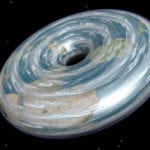 Weird Stuff
Weird Stuff  Weird Stuff
Weird Stuff  Mysteries
Mysteries 10 Tragic Disappearances and Deaths in Joshua Tree National Park
 History
History 10 Ways Childhood Really Sucked in the Old West
 Music
Music 10 Name Origins of Famous Bands from the 1990s
 Religion
Religion 10 Biggest Turnarounds by the Catholic Church
 Weird Stuff
Weird Stuff 10 Unbelievable Times Laws Had Unintended Consequences
 Humans
Humans Ten Historic Women Who Deserve Way More Credit Than They Got
 Movies and TV
Movies and TV 10 Films That Spawned Major Lawsuits
 History
History Ten Times Towns Were Wiped Off the Face of the Earth
 Creepy
Creepy 10 of the Most Disturbingly Haunted Public Houses in the UK
 Weird Stuff
Weird Stuff 10 Niche Subcultures That Are More Popular Than You Might Think
 Mysteries
Mysteries 10 Tragic Disappearances and Deaths in Joshua Tree National Park
 History
History 10 Ways Childhood Really Sucked in the Old West
Who's Behind Listverse?

Jamie Frater
Head Editor
Jamie founded Listverse due to an insatiable desire to share fascinating, obscure, and bizarre facts. He has been a guest speaker on numerous national radio and television stations and is a five time published author.
More About Us Music
Music 10 Name Origins of Famous Bands from the 1990s
 Religion
Religion 10 Biggest Turnarounds by the Catholic Church
 Weird Stuff
Weird Stuff 10 Unbelievable Times Laws Had Unintended Consequences
 Humans
Humans Ten Historic Women Who Deserve Way More Credit Than They Got
 Movies and TV
Movies and TV 10 Films That Spawned Major Lawsuits
 History
History Ten Times Towns Were Wiped Off the Face of the Earth
 Creepy
Creepy 10 of the Most Disturbingly Haunted Public Houses in the UK
10 Mind-Boggling Oceans That Exist In Space
The Earth is a mysterious place with the greatest unknowns lying in the oceans, which cover two-thirds of our wonderful world. When you consider the extreme conditions, phenomenal geological features, and eerie creatures that lie kilometers under the sea, your head may begin to hurt a tad. Well, be prepared to have it blown wide open, because when you read about the following breathtaking, awe-inspiring, unfathomable oceans that lie beyond our atmosphere and even our solar system, your brain may well explode.
10 The Diamond Oceans Of Neptune And Uranus

At the outer edges of the solar system lie two icy gas giants, Neptune and Uranus, both of which may play host to incredible diamond oceans. Beneath their atmospheres, both planets have similar mantles made up of water, ammonia, and methane ices. Due to their massive weights, their mantles are under a colossal amount of pressure where the temperature ranges between 1,727 degrees Celsius (3,141 °F) and 4,727 degrees Celsius (8,541 °F). It is under these extreme conditions that the methane breaks up into its core components, producing pure carbon, which under immense pressure forms into diamonds.
The high pressure coupled with the intense heat causes the diamonds to actually melt, forming diamond oceans toward the base of the mantle. Just as water in its solid form floats on top of its liquid component, solid diamond will float over liquid diamond, meaning there could well be actual “diamond-bergs” floating on top of the diamond oceans. There are even theories suggesting it actually rains diamonds on Uranus, too.
The existence of these magnificent oceans has been hypothesized through experiments at the Livermore National Laboratory, where scientists recreated the extreme conditions of the ice giant’s mantles through lasers, melting diamonds into their liquid form. Should these diamond oceans exist, then we will finally have an explanation as to why both planets have magnetic poles offset from their axes.
9 Io’s Magma Ocean
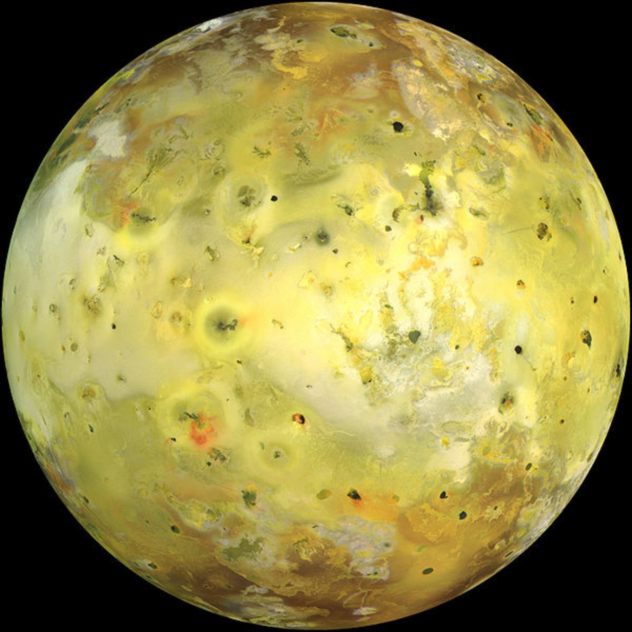
Io is the most volcanic body in our solar system. Boasting over 400 volcanoes, its surface is constantly plagued with explosions and lava flows. The reason for such violent and frequent volcanic activity can be explained by a global magma ocean located 50 kilometers (31 mi) beneath the moon’s surface.
The magma ocean is kept in its molten state through two spectacular heat generation methods, one of which involves Io’s peculiar orbit. Situated between Jupiter and two of the Galilean moons, Europa and Ganymede, Io’s orbit is distorted into an elliptical shape, meaning it is sometimes closer to Jupiter for parts of its orbit. Due to the gravitational pull of the planet, Io’s surface bulges in and out to heights of up to 100 meters (328 ft). It’s this tidal pumping that generates an immense amount of heat within Io, keeping the magma ocean in a liquid state while inducing volcanic mayhem on the surface.
Io also receives a tremendous amount of heat through electrical resistance. Orbiting at a mere 422,000 kilometers (262,000 mi) from Jupiter, Io actually cuts through the gas giant’s enormous magnetic fields, turning the little moon into an electric generator, creating 400,000 volts across itself and inducing a whopping 3 million amperes of current. It’s this current that’s also responsible for creating lightning in Jupiter’s upper atmosphere.
8 Pluto’s Underground Nuclear Ocean
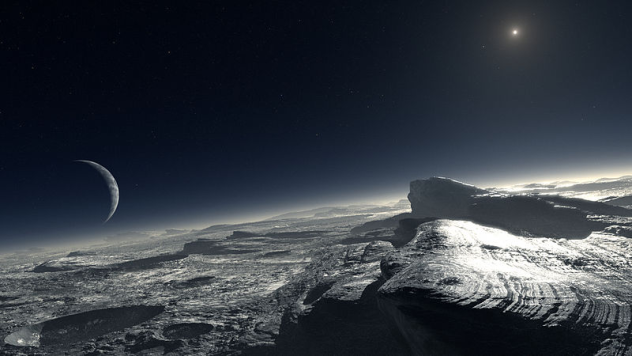
In 2015, the New Horizons probe will conclude its 3,000-day mission to the very edge of our solar system, entering the orbit of the icy ex-planet Pluto. Through low-resolution images, inferred data from orbits, and emission spectra, scientists can only speculate what lies on the surface of Pluto. They can, however, make plenty of educated guesses, one of which is the existence of an underwater ocean.
With a surface temperature of –230 degrees Celsius (–382 °F), the very thought of liquid existing on this barren orb seems completely baffling until you take into account what actually makes up Pluto’s rocky core. Like many other planets in our solar system, radioactive elements lie beneath Pluto’s surface, specifically uranium, potassium-40, and thorium. When these elements undergo radioactive decay, they release enough heat to keep water in its liquid state. So while the surface of Pluto may be well below freezing, there could be an underground nuclear ocean. Only when the New Horizons probe reaches Pluto will this likely scenario be confirmed or disproven.
7 Kepler-62e: The Ocean Planet
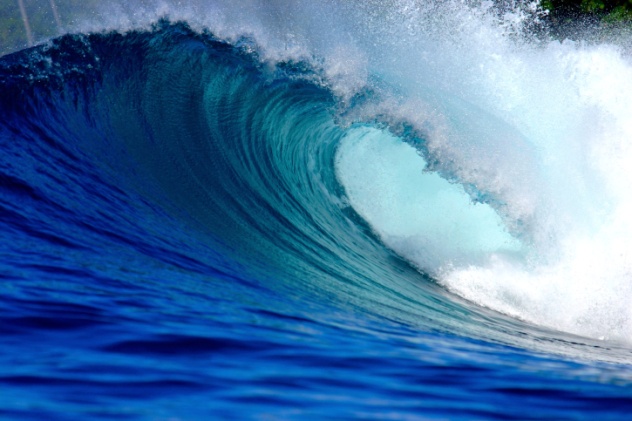
The eloquently-named Kepler 62e orbits a red dwarf star unsurprisingly called Kepler-62, which has at least five planets caught in its orbit. Two of these, Kepler-62e and 62f, are in the all-important habitable zone. (Note that astronomers start naming exoplanets with the letter “b,” so there is no Kepler-62a.) Kepler-62f is slightly further from its parent star, and chances are this planet is completely frozen over. Kepler-62e, on the other hand, might be just the ticket.
Even though Kepler-62e’s orbit is at a distance on par with that of Mercury’s, because its parent star is much cooler than our sun, Kepler-62e still sits comfortably in the habitable zone. The ocean has only been theorized through various models, but the chance of a global ocean existing on this distant world is quite high. However, until we get closer to Kepler-62e, we will never know for sure if it is indeed a wet, wet world in a solar system far, far away.
6 Kepler-22b: The Ocean Exoplanet Most Likely To Support Life
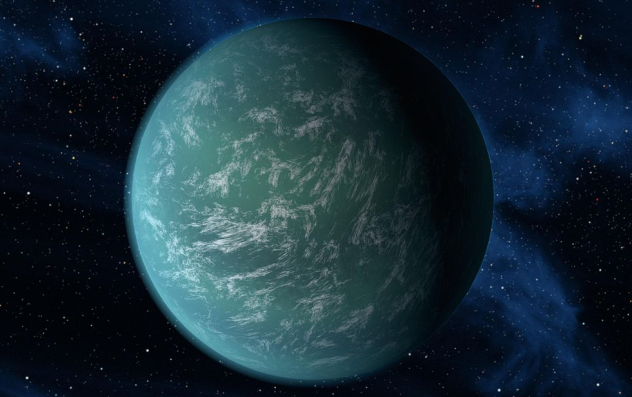
Kepler-22b could be an ocean planet and sits perfectly in the habitable zone that some astronomers call the “Goldilocks region.” This is where the surface temperature is neither too hot nor too cold, allowing liquid water to exist on the surface. As we all know, water is essential if life is to flourish, meaning that this distant world could host extraterrestrial life.
However, just because the planet is within the habitable zone doesn’t automatically mean that it’s going to have water. Some astronomers speculate that Kepler-22b could in fact be a smaller gas giant. At over 600 light-years away, it is going to be difficult to be sure whether the planet is Earth’s twin or not, but as Natalie Batalha, Kepler deputy science chief, said, “It’s not beyond the realm of possibility that life could exist in such an ocean.”
5 Enceladus’s Underground Ocean That Could Host Life
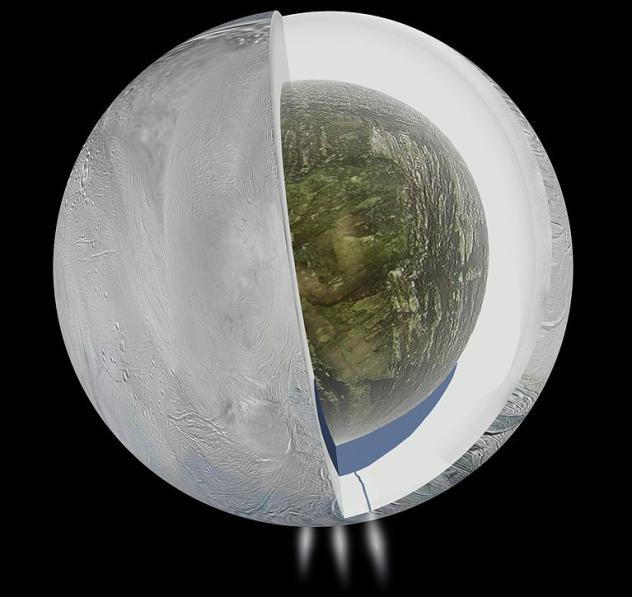
Across the southern polar region of Saturn’s sixth-largest moon lie four “tiger stripes,” depressions in the surface that are rife with cryovolcanic activity. The cryovolcanoes spray roughly 250 kilograms (551 lb) of water vapor every second. Most of it falls back to the moon’s surface, but some escapes into Saturn’s outer E Ring. Analysis of the E Ring found sodium salts within the ice grains, exactly the kind of salts you would find from an ocean, initially sparking the idea that a salty underground ocean may lie beneath the surface.
During the flyby missions in 2012, Cassini confirmed the presence of an ocean by detecting the water’s gravitational signal. Scientists were able to determine that there is an ocean of liquid water beneath the surface, and its volume is roughly equal to Lake Superior’s. Though it hasn’t been confirmed whether this is a global underwater ocean or not, it is certainly at its thickest beneath Enceladus’s south pole. Not only is Enceladus’s underground ocean made of liquid water, but it is also one that contains organic compounds (sodium salts), meaning that the core ingredients for life to exist are all there, making this little Saturnian moon a key contender for extraterrestrial life in our solar system.
4 Ceres And Its Impossible Underwater Ocean
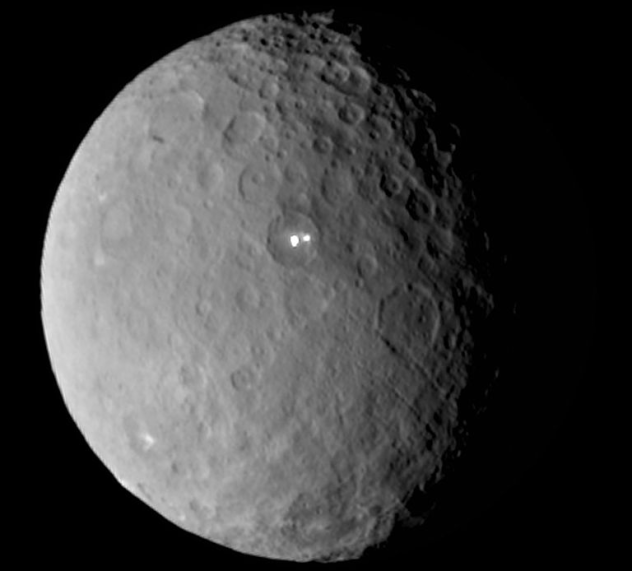
Though Ceres is the largest object in the asteroid belt and even accounts for a third of the belt’s total weight, this tiny dwarf planet is no bigger than the state of Texas. By astronomical standards, Ceres is tiny, with a diameter of 950 kilometers (590 mi), making the presence of a muddy underwater ocean even more mind-boggling.
Much like the formation of any planet in our solar system, Ceres was heated through radioactive decay, allowing it to separate into a rocky core and icy mantle. However, due to its small stature, Ceres cooled off quickly, leaving the surface inactive and the ice to solidify. This was thought to be the case until the Dawn satellite performed a flyby, discovering a bright object within a large crater about 80 kilometers (50 mi) across. Some scientists speculate that this bright spot, known as “Feature 5,” could be a cryovolcano, meaning there is an underground ocean beneath the surface of this minute world.
This may not seem very surprising until you consider that Ceres is over 6,500 times smaller than Earth and could fit snugly inside of France. It’s really quite impressive that this little world has its own underground ocean.
3 The Biggest Ocean In The Solar System

Beneath the 50-kilometer-thick (31 mi) destructive clouds of Jupiter lies a mammoth ocean of liquid hydrogen. Making up a whopping 78 percent of the planet’s radius, the ocean is 54,531 kilometers (33,884 mi) deep. To put that into perspective, the deepest point of Earth’s ocean is the Challenger Deep in the Mariana Trench, which lies at a scant 11 kilometers (7 mi) below the surface.
But it’s not just the sheer size of the ocean that’s totally incomprehensible; it’s the conditions under which it exists. In order to convert the hydrogen gas into a liquid, you need to compress it with an insane amount of pressure; 100 million times that of Earth’s atmospheric pressure should do it. Under these conditions, the liquid hydrogen inside Jupiter takes on a profound characteristic and becomes something called liquid metallic hydrogen. Pressures this high simply cannot be recreated on Earth, so this is only a theory right now, but it suggests that the extreme state of Jupiter’s interior causes electrons to be released from hydrogen atoms, allowing the creation of heat and electricity, key properties of a metal. Hence, Jupiter hosts not only the largest ocean within our solar system but also one of the most extreme.
2 Lobster Oceans
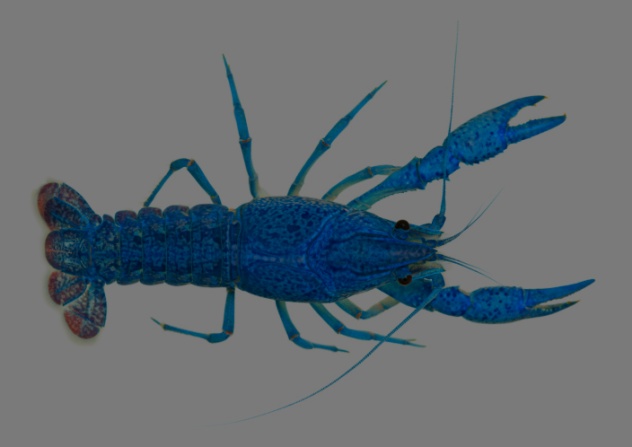
It has been theorized that certain exoplanets may contain “lobster oceans.” Now, before all you Red Lobster fans pack your bibs and blast off in search of a planet-wide, all-you-can-eat seafood buffet, remember that these oceans are lobster-shaped and only theoretical at this point. Lobster oceans might exist on exoplanets that are tidally locked, a state where the planet doesn’t rotate, and one side is permanently facing toward its parent star.
According to various computer models, lobster oceans would be found on an exoplanet’s day side. One such model investigated atmospheric circulations, ocean circulations, and how they affect each other. Using exoplanets from the Gliese-581 system, the model assumed that there was a global ocean present, similar in depth to Earth’s ocean and with an atmosphere full of carbon dioxide. What was found was incredible.
Instead of a round ocean, which is what you would expect, an elliptical one appeared, with its longer side running along the equator. Incredibly, two “claw-like” shapes protruded from the ocean as well, creating a lobster-shaped body of liquid. These claws were created by ocean currents that rotate like cyclones due to jet streams. The “tail” of the lobster is caused by a Kelvin wave, which also results from a jet stream. No lobster oceans on tidally locked exoplanets have been discovered so far, although that is simply due to the lack of a telescope powerful enough to observe them. So you may want to hold off on melting the butter for a few more years.
1 The Hellish Lava Ocean Planet
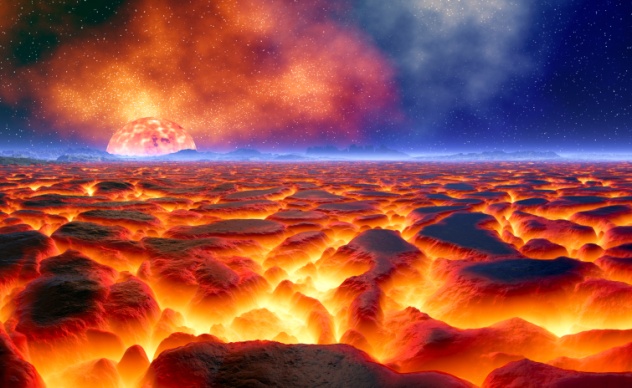
The name Alpha Centauri should ring a bell, as it’s the closet star to our sun at a meager 4.2 light-years away. Similar in size to the Sun, this distant star has at least one planet orbiting it and possibly several others. Using various Doppler effect techniques, an Earth-sized planet was discovered orbiting Alpha Centauri B, which was lovingly called Alpha Centauri Bb.
However, Alpha Centauri Bb is not in the habitable zone; in fact, it is more like Hell. Set at 0.04 astronomical units (AU) from its parent star (in other words, 25 times closer than we are to ours), its surface temperature is around 1,200 degrees Celsius (2,200 °F), almost three times hotter than the surface of Venus, which is the hottest surface temperature in our solar system. Temperatures this high would lead to molten rock entirely covering the planet’s surface, meaning life, as we know it at least, would be utterly impossible on this distant world.
Alpha Centauri Bb still remains a theory, albeit quite a likely one, and astronomers still debate the planet’s existence. Either way, the fact that there could be a molten fiery Hell planet in our nearby universe is attractive.
My name is Andy, and I like to write things. I write reviews for DeadPress.co.uk and 7BitArcade.com, and I dabble in a bit of satire over at Undergroundmgzn.com. I prefer gigs over clubs, whiskey over wine, and Christina Hendricks over any woman ever made, ever.

